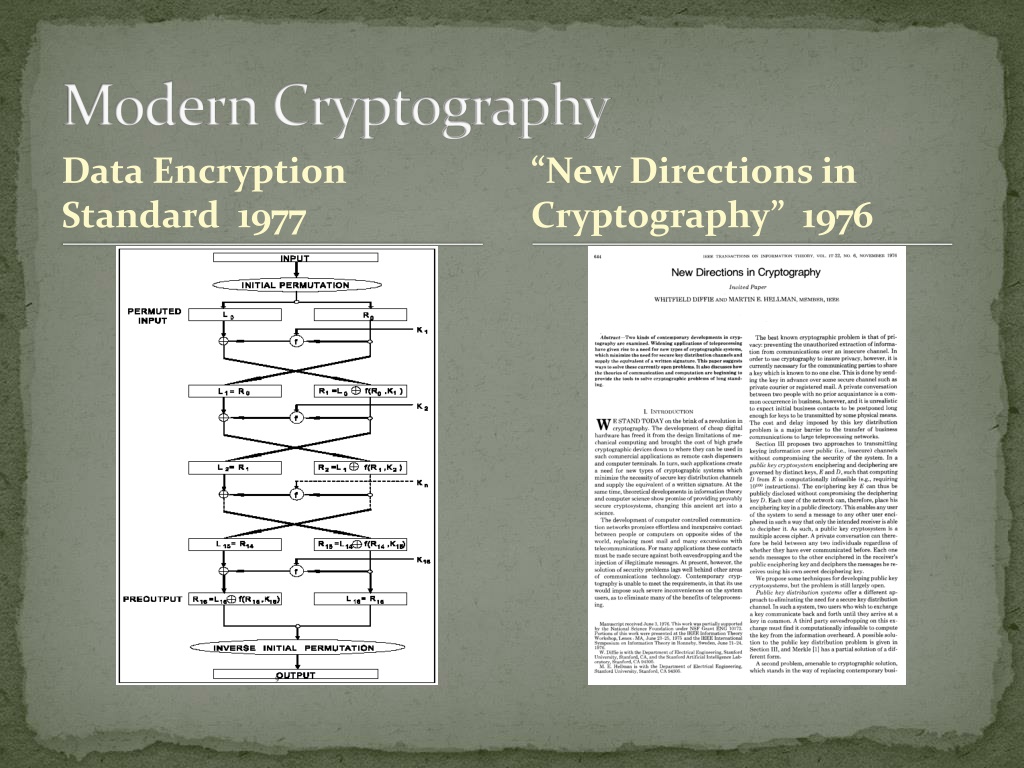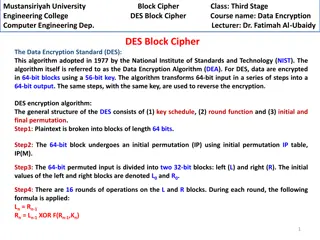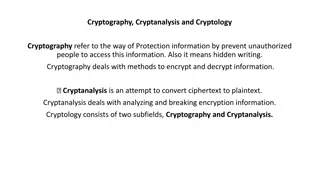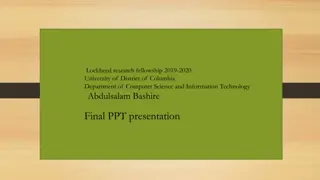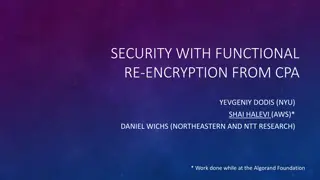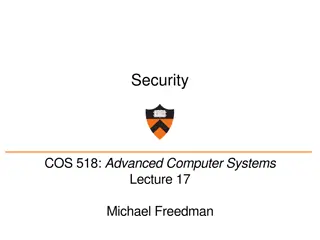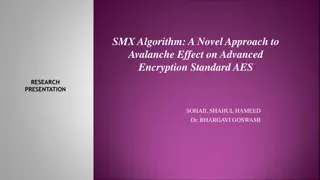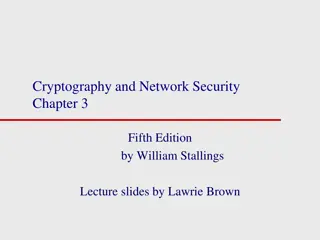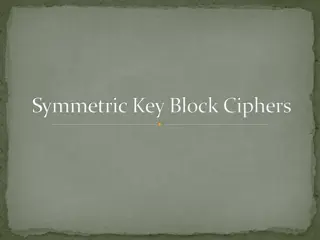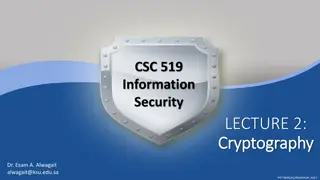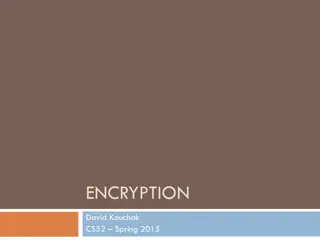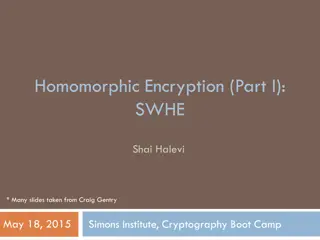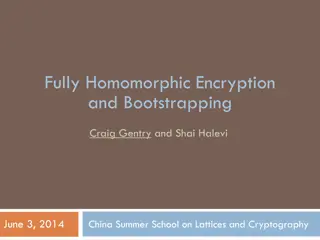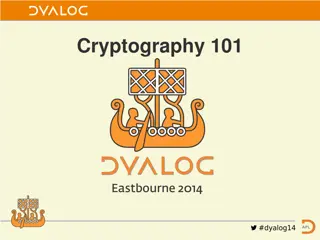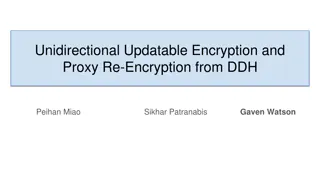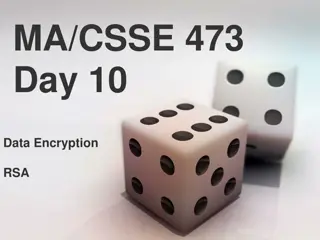Overview of Modern Cryptography and Data Encryption Standard (DES)
Exploring modern cryptography including symmetric key block ciphers, public key ciphers, stream ciphers, and post-quantum ciphers. Focus on Data Encryption Standard (DES), Simplified DES, Feistel cipher, key schedule, expansion function, S-Box, DES encryption, and decryption processes.
Download Presentation

Please find below an Image/Link to download the presentation.
The content on the website is provided AS IS for your information and personal use only. It may not be sold, licensed, or shared on other websites without obtaining consent from the author. Download presentation by click this link. If you encounter any issues during the download, it is possible that the publisher has removed the file from their server.
E N D
Presentation Transcript
Modern Cryptography Data Encryption Standard 1977 New Directions in Cryptography 1976
Ciphers Symmetric key block ciphers Public key ciphers Stream ciphers Post-quantum ciphers
Data Encryption Standard 1977 Horst Feistel (1915 1990) Simplified DES: Wade Trapp and Lawrence Washington
DES DES Simplified DES 64-bit block 56-bit key (8 parity bits) 8 S-boxes 6 x 4 16 rounds Feistel cipher 12-bit block 9-bit key 2 S-boxes 4 x 3 4 rounds Feistel cipher
Key Schedule 9 bits of key 111 010 110 Use the 8 bits on the left for k1 1110 1011 Rotate to the left one bit 110 101 101 Use the 8 bits on the left for k12 1101 0110 Rotate to the left 1 bit 101 011 011 Use the 8 bits on the left for k3 1010 1101 Rotate to the left 1 bit 010 110 111 Use the 8 bits on the left for k4 0101 1011
S-Box 0 1 2 3 4 5 6 7 0 1 2 3 4 5 6 7 S S 1 2 0 1 101 010 001 100 110 001 110 011 100 111 000 000 111 101 011 0 1 100 101 000 110 101 111 011 000 111 110 001 011 010 010 001 100 010
DES Encryption L R i i = = , L R R L f R K + + i i i i 1 1 i i
DES Decryption L R i i Encryption = = , L R R L f R K + + i i i i 1 1 i i = = , L R R L f R K + + i i i i 1 1 i i Decryption = = , L R f R K R L + + i i i i 1 1 i i
DES Decryption Encryption Decryption
Secrecy of Algorithm Backdoor?
3DES 112-bit security 1plaintext K E D E 3 2 K K
Security Level Perfect Security Random key, as long as the message, and used only once. Computational Security Symmetric Key RSA and DH ECC 80 112 128 192 256 1024 2048 3072 7680 15360 160 224 256 384 521 Today 112
64-bit block 80-bit key 32 rounds Unbalanced Feistel cipher Skipjack/Clipper Chip Skipjack declassified 1998 Clipper Chip 1993 -1996
Substitution-Permutation Networks Claude Shannon (1916 2001)
Claude Shannon A Mathematical Theory of Communication 1948 The Theory of Secrecy Systems 1949
The Theory of Secrecy Systems 1949 Diffusion: the statistical structure of [the message] which leads to its redundancy is dissipated into long range statistics. Wire crossing, P-box Confusion: make the relation between the simple statistics of [the ciphertext] and the simple description of [the key] a very complex and involved one. S-box
PRESENT 2007 Many
PRESENT 64-bit block 80- or 128-bit key 1 S-box 4 x 4 31 Rounds Substitution-Permutation Network
Do Cryptographers Sleep Well? How do they know it s secure?
Advanced Encryption Standard 2001 Joan Daemen and Vincent Rijmen Simplified AES: Mohammad Musa, Edward Schaefer, and Stephen Wedig
AES (Rijandael) AES Simplified AES 128-bit block 128-bit, 192-bit, or 256-bit key 10, 12, or 14 rounds SPN 16-bit block 16-bit key 2 rounds SPN
S-Box 1 x = y xy= 1
0 1 2 3 k k k k k k k k 8 9 10 11 k k k k k k k k 5 7 4 6 12 13 14 15 W[1] W[0] Add Key
pt S-AES A K 0 NS SR MC A K 1 NS SR A K 2 CT
